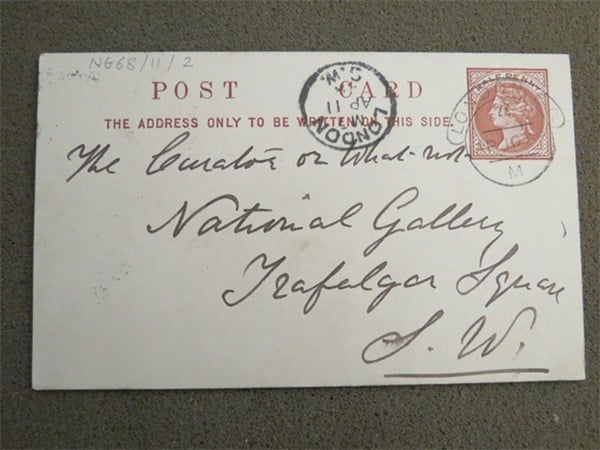
To the reader or whoever: If you ever thought slack irreverence was just a byproduct of modern-day malaise, a British researcher has uncovered evidence suggesting otherwise.
Alison Clarke, a PhD candidate at the University of Liverpool, is researching the relationship between Britain’s National Gallery and legendary art dealer Agnews in the 19th century. She recently came across a curious 1888 postcard addressed to “The Curator or What not” at the museum in Trafalgar Square. artnet News first saw the note flagged on Bendor Grosvenor’s always-fascinating blog Art History News.
Photo by Alison Clarke
Perhaps even more unusual is the finicky, grammar-focused nature of the note. On the reverse, the unsigned, anonymous postcard contains a complaint about a label on the frame of the work Mater Dolorosa from the workshop of Dirk Bouts. The glaring error? A masculine “o” instead of the feminine “a” at the end of the word “doloroso” which means “sorrowful.”
The note reads: “A visitor at the National Gallery Sunday (April 10) would suggest that a slight (?) error on one of the new picture frames be corrected. 711 Mater Doloroso by Rogier Van de Weyden (the Younger) Born 1450 Died 1529 Flemish School. Presented by Her Majesty the Queen in fulfilment of the wishes of His Royal Highness the Prince Consort. An unfortunate mistake”
The postcard contains marking in red emphasizing the “o” at the end of “Doloroso” presumably made by a museum recipient who read the note. (Clarke says: “I’m not sure whether the ‘o’ was emphasized by the original writer or the museum—the museum, I expect?”). A further note at the bottom in a different shade of red ink that reads “attended to 12.4.88” indicates that the museum acted on the information quickly after it was notified.
Clarke, who is in the third year of a joint program with the National Gallery, told artnet News: “I liked the postcard because of the specific nature of the ‘unfortunate mistake’ that the anonymous writer wanted to be corrected, and because of the assumption that a letter addressed like this would reach the correct person—I imagine it still resonates quite strongly with curators today!”
Clarke said she is researching the subject of connoisseurship and display and frequently uses the National Gallery archives as one of the main sources for her research.
When she came across this postcard, Clarke was researching the kind of information that the National Gallery provided to the public on its paintings in the late 19th century. She says “the type of detailed text labels provided now didn’t come into use until the mid-20th century, so visitors had to be guided by frame labels (which gave information like the name of the donor, painting inventory number; title; attribution; birth and death dates of artist; and school) and by the official or unofficial catalogues for sale at the Gallery. I’m trying to find out how the Gallery communicated its connoisseurship and research to the public (and to what extent the public agreed or disagreed!).”